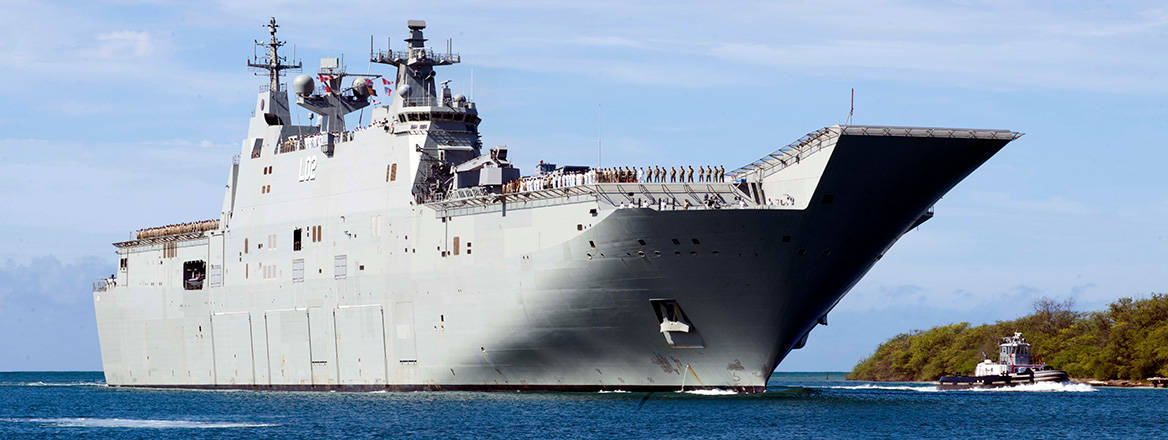Australia’s Quest for an ‘Impactful Projection’ Defence Force
Australia’s latest Defence Strategic Review must effectively respond to a rapidly changing geopolitical environment.
Australia’s new government is active on many fronts, including defence. During the May election, the then opposition Australian Labor Party argued that the 2020 Defence Strategic Update stated that a conflict could begin in less than the 10 years’ warning time assumed for the last few decades, but then no tangible action was taken by the government in response. Accordingly, after its victory, the new government quickly began a Defence Strategic Review, with the preliminary report handed in on 1 November and the final report due ‘no later than March 2023’. This fast pace was justified as necessary in the ‘rapidly changing strategic circumstances’.
A Focused Government
Such a review normally takes 18 months, not eight, but the review is now understood to be based on some firm government guidance. Anthony Albanese, the new prime minister, views some of the Australian Defence Force’s (ADF) current force-modernisation plans as a reflection of the past 20 years of counterinsurgency wars across the greater Middle East, and thus inappropriate for the next 20 years of Indo-Pacific strategic possibilities. In a rhetorical mood, he asked: ‘Are we going to be involved in a land war, in central Queensland [an Australian state]?’ Instead, Albanese sees missiles, missile-defence capabilities, drones and cyber security as now needed, declaring ‘in general, we need more weaponry that can actually make a difference’.
Richard Marles, the defence minister and deputy prime minister, has fleshed these comments out. Before the review began, he stated that the new government:
‘will make the investment necessary to increase the range and lethality of the Australian Defence Force so that it is able to hold potential adversary forces and infrastructure at risk further from Australia. This will include capabilities such as longer-range strike weapons, cyber capabilities and area denial systems tailored to a broader range of threats, including preventing coercive or grey-zone activities from escalating into conventional conflict. We will invest in the logistics, sustainment and depth required for high-intensity war fighting, including guided munitions'.
The minister now terms this ‘impactful projection’ – military power applied at a substantial distance from Australia that has a meaningful strategic impact. The idea has gained bi-partisan backing. Andrew Hastie, opposition shadow defence minister and an ex-Australian Army officer, is firmly in agreement, arguing for an ADF able to strike targets ‘beyond the [Indonesian] archipelago to our north’ and suggesting acquiring bombers, precision-guided missiles, and air and sea unmanned autonomous vehicles. In the public arena, the conservative Murdoch press is equally enthusiastic.
A Supportive Review
Given such unanimity, the review may be more properly seen as mainly involving adjusting the extant defence investment plan to the new government’s guidance. The review is then tidying up around the edges in a technocratic planning sense, such as by tweaking major acquisition project timelines, one of the five tasks set out in the terms of reference. It now makes sense that the review has undertaken very limited consultation to simply within government, several Australian branches of certain large overseas defence companies, and those think tanks that are either government-owned or have one of the review team as members. The extensive consultation of earlier reviews aimed at getting acceptance for change among insiders, industry, academia and the public is not needed this time.
The new prime minister sees missiles, missile-defence capabilities, drones and cyber security as now needed
The downside of keeping the review ‘inside the tent’ is a limited likelihood for innovation, but the upside has been excellent secrecy. Indeed, the only leak has been of the cost – £450,000 – of the two consultants. Such confidentiality is important given that a selection decision on the type of a new infantry fighting vehicle is now overdue.
Altering this AU$30 billion project would free up large sums for new project possibilities. The retort of not force structuring to fight a land war in central Queensland now sounds ominous. Delay might be the easiest option to sell politically. In earlier times, the approach of splitting projects into first having a small purchase for training purposes, followed by later large-scale acquisition phases, was used. On the other hand, acquiring missiles such as Tomahawk, JASSM-ER, SM-6 and NSSM now looks rather promising, with a fair chance of the Air Force’s Sea Guardian drone project – cut last year by the previous government – being restarted.
The Devil is in the Details
The ADF needs to recruit 13,000 more people in this decade to operate the new capabilities already planned. The ADF however, has only been able to grow by 300 people annually in the past five years. The review seems to be overlooking this fundamental issue. Suggesting new capabilities that are unable to be crewed seems like planning to end up where Canada is now: 10,000 personnel short. New capabilities need to fit in with Australian society; the reverse is clearly unsustainable.
The review is being built on impactful projection, but this is still an immature concept, as Minster Marles freely admits. Certainly, the idea of trying to make an impact raises the question of what the outcome sought is. At the moment, the focus is on equipment rather than on what the strategic gains of acquiring such equipment might be.
The downside of keeping the review ‘inside the tent’ is a limited likelihood for innovation, but the upside has been excellent secrecy
In this, the federal budget is facing five serious spending pressures: interest payments on debt; the National Disability Insurance Scheme; healthcare; aged care; and defence. Ambitious plans now appear unreasonable with modest ones offering obvious value for money more palatable. Accordingly, the most ambitious plan, acquiring nuclear submarines, has been excluded from review consideration. Nevertheless, over time, its resource impact will mean the rest of the ADF needs to be rebalanced, and this cannot be forever disregarded.
The new Albanese government knows what it wants in defence and is actively working to get at least some of it. Crucially, however, the current focus on weaponry seems to somewhat neglect the logistics and sustainment critical to fighting a war in this decade. The review might yet be deemed a government success but fail to meet its reason for being.
The views expressed in this Commentary are the author’s, and do not represent those of RUSI or any other institution.
Have an idea for a Commentary you’d like to write for us? Send a short pitch to commentaries@rusi.org and we’ll get back to you if it fits into our research interests. Full guidelines for contributors can be found here.
WRITTEN BY
Dr Peter Layton
RUSI Associate Fellow, Military Sciences
- Jim McLeanMedia Relations Manager+44 (0)7917 373 069JimMc@rusi.org


